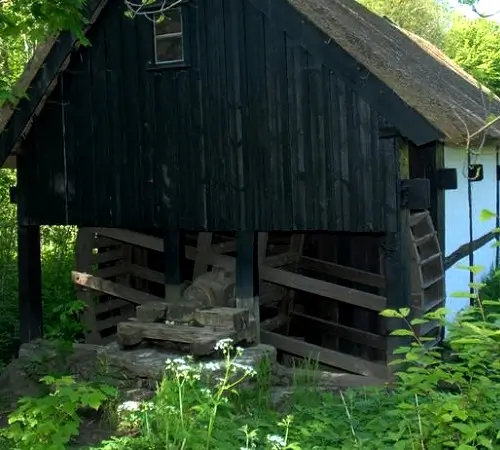
Bornholm, known as "The Mill Island," is a Danish gem with a rich history of mills. At its peak, the island boasted over 200 mills, including windmills and watermills. Today, visitors can admire around 20 preserved mills, such as Denmark's largest windmill in Gudhjem or the oldest functioning mill in Årsdale.
The first windmill on Bornholm was built around 1500 near Hammershus Castle. Initially, mills were used solely for grinding grain. However, with the industrial development of the 17th century, they began to power devices in other industries as well.
Mills were evenly distributed across the island, but the best-preserved examples today are found in the eastern, northern, and southern regions. Both windmills and watermills are not only tourist attractions but also stand as testaments to Bornholm's rich history and technological progress.
Visiting Bornholm would be incomplete without exploring these unique landmarks. The windmills and watermills offer a rare opportunity to travel back in time and understand how the island functioned in earlier centuries. They are a perfect attraction for history enthusiasts, technology buffs, and lovers of scenic landscapes alike.
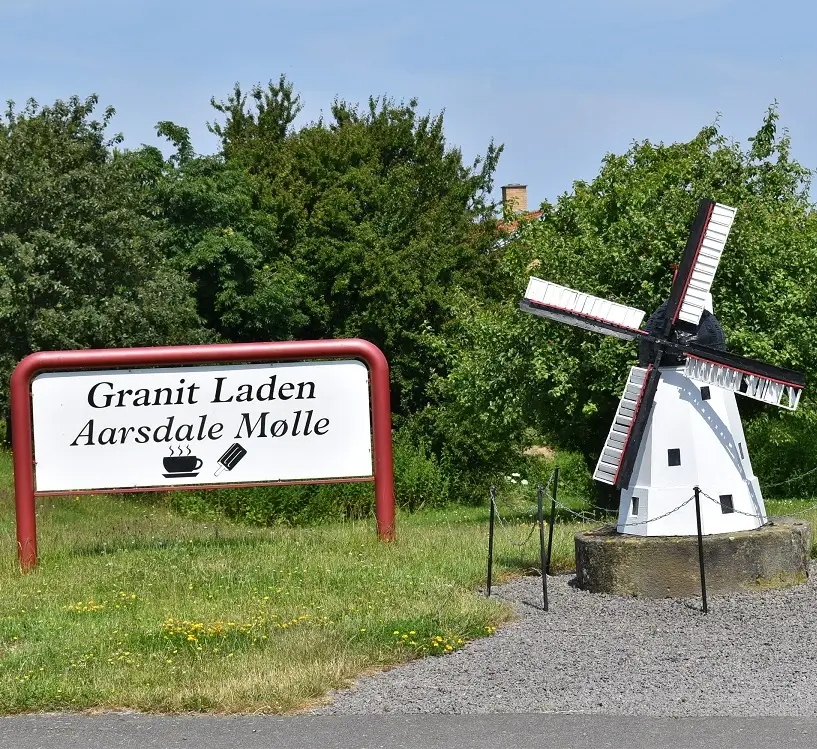
Gudhjem Mill – The largest windmill in all of Denmark, admired for its monumental structure and picturesque location.
Årsdale Mill – The oldest functioning windmill in Denmark, a true symbol of longevity and the island's technological heritage.
Bornholm features a variety of mill types, showcasing the evolution of technology and adaptation to local conditions:
Post mills – The oldest and simplest designs, where the entire structure was turned to face the wind.
Dutch windmills – More modern constructions with rotating caps, which were more efficient and durable.
Watermills – Powered by flowing water, perfectly suited for areas near streams and rivers.
Post mills, dating back to the 16th century, are among the oldest mill designs in Europe. They are characterized by a structure built on a massive wooden post (known as the "post"), allowing the entire mill to be rotated to face the wind using a lever. This unique type of mill can also be admired on the Danish island of Bornholm, where three preserved post mills are still standing and operational today.
Bechs Mill in Svaneke – The oldest windmill in Denmark, a true historical gem and one of Bornholm's iconic landmarks.
Egeby Mill in Åker – Picturesquely located along the road from Rønne to Nexø, it attracts history and architecture enthusiasts.
Tejn Mill in Melsted – Still admired for its construction, it serves as a reminder of the days when wind power was essential to the island's livelihood.
Post mills are not only unique examples of ancient engineering but also integral elements of Bornholm's cultural landscape. Visiting these historic sites offers a chance to step back in time and experience how these ingenious structures operated, serving as the economic backbone of the local community for centuries.
Bechs Mølle, a post mill, proudly stands on the northern outskirts of Svaneke and is one of Bornholm's most significant landmarks. Built in 1629, it is not only the largest of the three remaining post mills on the island but also the largest post mill in all of Denmark. Its impressive history and importance to the local community make it a unique tourist attraction.
The History of Bechs Mølle
Originally constructed as a windmill, it was named after HB Bech, who purchased it in 1814 when it was already nearly 200 years old. In 1857, the mill underwent expansion with the addition of a house and a bakery. In 1866, it was completely dismantled and relocated to a new site due to road construction. During the relocation, some parts were replaced, and the structure was enlarged.
The mill operated until 1928, after which it came under the care of the Friends of Bornholm Association. Thanks to restorations carried out in 1960, 2004, and 2007, Bechs Mølle has been preserved in excellent condition. Today, it stands not only as a testament to historical technology but also as a symbol of Bornholm’s rich heritage.
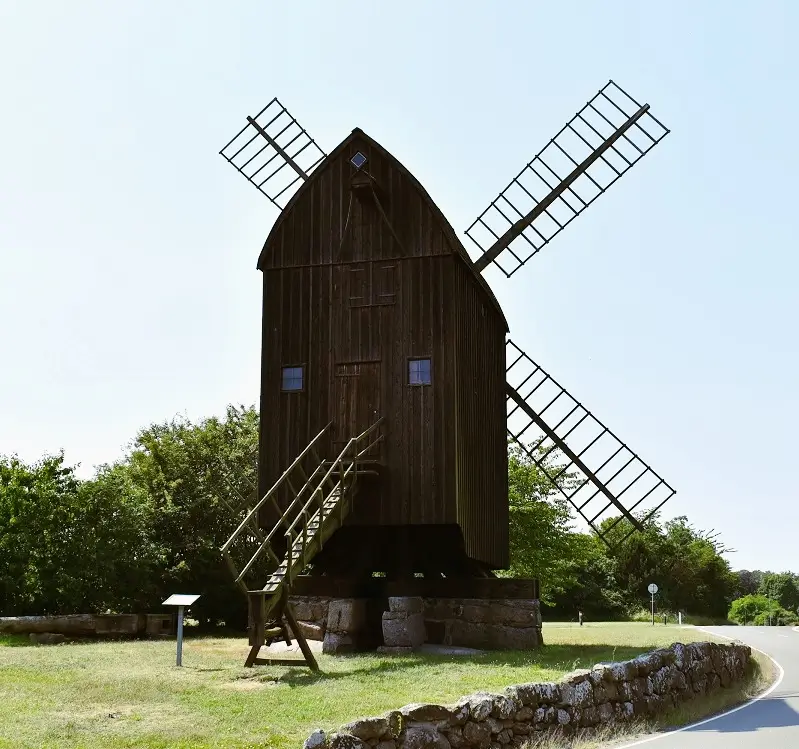
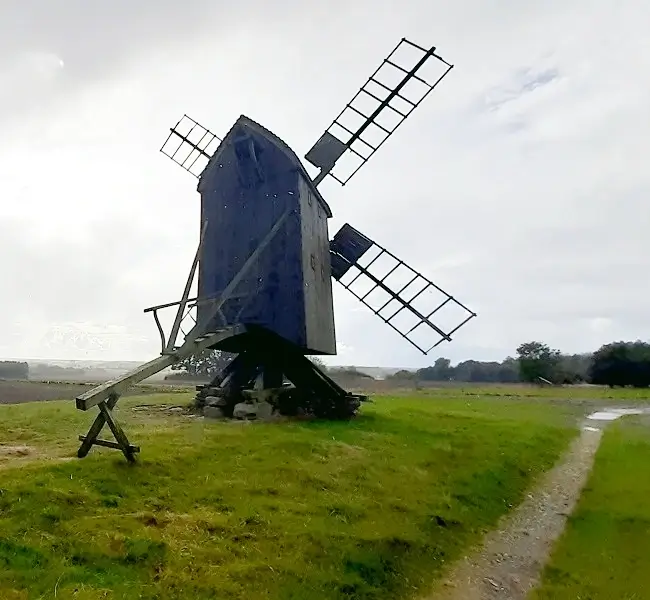
Egeby Mølle, located between Bodilsker and Aakirkeby, is the most distinctive of the three preserved post mills on Bornholm. Built in 1787, the mill underwent significant changes in 1794 when it was relocated and restored after being struck by lightning. Its unique design and eventful history make it a remarkable landmark of Bornholm.
The History of Egeby Mølle
The mill operated until 1920, playing a key role in the local community. In the 1950s and 1960s, many of its parts were replaced, though original elements such as the millstones were preserved. Unfortunately, in 1987, the mill's sails were dismantled after damage caused by a storm. Between 1996 and 1999, a thorough restoration was carried out, during which it was discovered that the mill was originally 3 meters narrower. Thanks to these efforts, Egeby Mølle regained its former glory and is now fully operational.
Tejn Mølle, also known as the Melsted Mill, is a wooden post mill located in Melsted, right next to the Melstedgaard Agricultural Museum – a popular attraction visited by 30,000 tourists annually. Although the mill now stands in Melsted, it was originally built around 1800 in Årsballe, in the central part of Bornholm.
The History of Tejn Mølle
The windmill was relocated to its current site in 2006, where it became an integral part of the Melsted landscape and the nearby Agricultural Museum. It is one of the few remaining operational mills on Bornholm and is used to produce animal feed, perfectly complementing the educational mission of the museum. Its unique location and functionality make it both a tourist attraction and a living testament to times gone by.
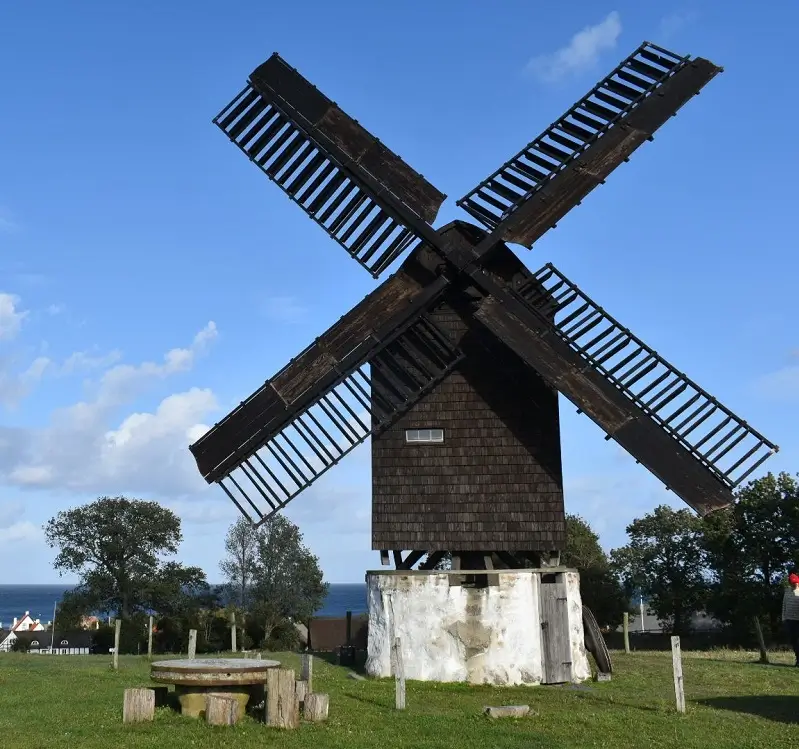
In the mid-18th century, Dutch windmills were introduced on Bornholm as a modern technological innovation of their time. Unlike the older post mills, Dutch windmills featured a rotating cap with attached sails, allowing for the construction of larger structures with more interior space for machinery. The first such windmill was built in Rønne in 1793, marking the beginning of a new era of milling on the island.
Dutch windmills were distinguished by their rotating cap, which enabled better utilization of wind and significantly improved efficiency. The spacious interiors allowed for the installation of more advanced machinery, making them far more effective than older designs.
Today, 12 preserved Dutch windmills remain on Bornholm, serving not only as examples of historical engineering but also as iconic elements of the island's landscape. They are a perfect representation of the technological advancements in milling, adapting to the changing needs and possibilities of their era.
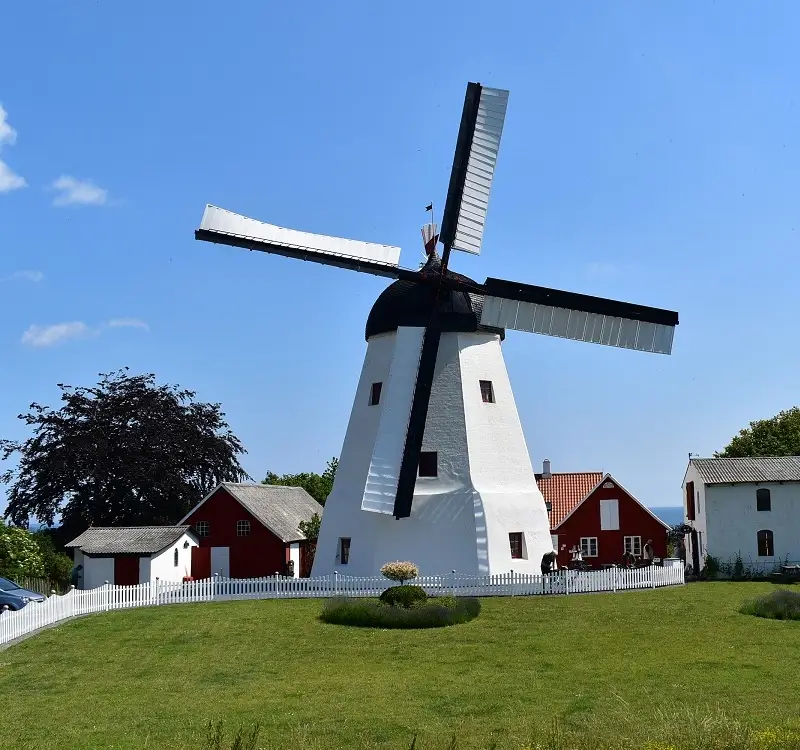
Aarsdale Mølle is an impressive Dutch windmill, built in 1877, perched atop a hill at the southern edge of Aarsdale, just 3 km south of Svaneke. Known as the "queen" of Dutch windmills on Bornholm, it is the only windmill in Denmark that has been in continuous operation since its construction, still grinding grain and producing fresh flour to this day.
The Uniqueness of Aarsdale Mølle
As the only windmill in Denmark to have operated continuously since 1877, Aarsdale Mølle is not only a functioning piece of historical engineering but also a living symbol of Bornholm's milling traditions. Visitors can explore the mill's interior and witness the grain milling process, making it a truly unique experience. Additionally, a nearby shop offers freshly milled flour produced on-site, adding a tangible connection to this historic landmark.
Myreagre Mølle is an extraordinary windmill located along the picturesque road connecting Aakirkeby and Nexø. Its distinctive octagonal exterior and round interior draw the attention of tourists, making it a popular photography spot. Built from local sandstone, the mill stands out with its unique construction technique, different from other Bornholm windmills, such as the Kirke mill.
The History of Myreagre Mølle
The mill was purchased in 1913 by the father of the current owner, who modernized it in 1921 and added a bakery in 1925. For many years, Myreagre Mølle played an important role in the local community. However, the bakery closed in 1962, and the mill ceased operations in 1970. Although renovations were carried out in the 1980s, the mill is now deteriorating due to a lack of further maintenance.
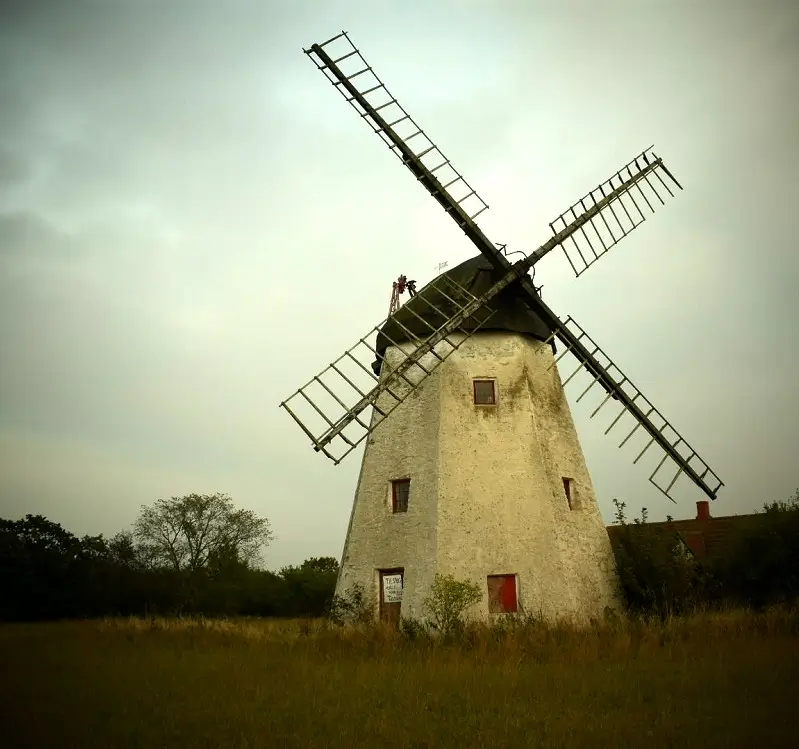
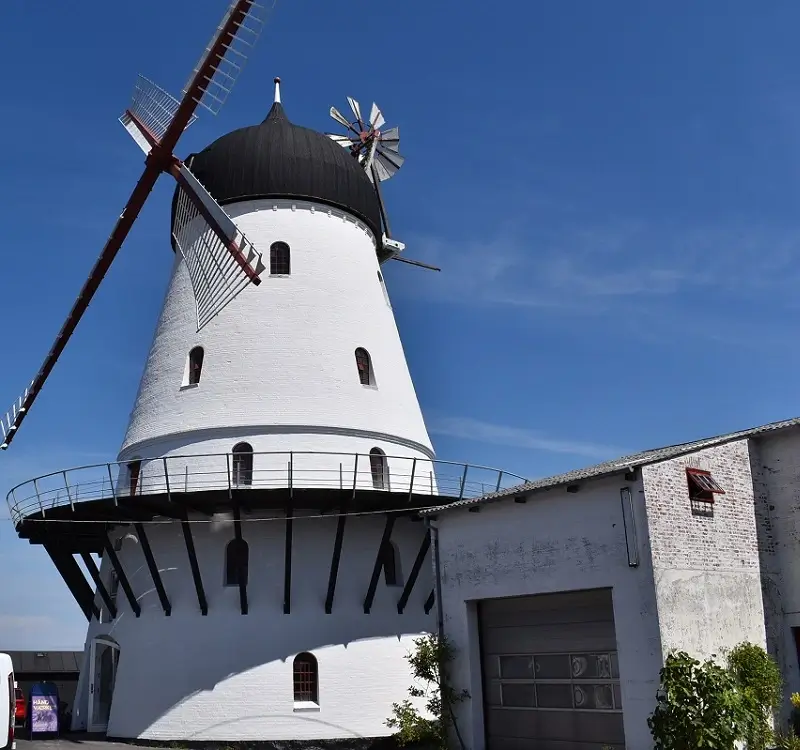
Perched on Møllebakken 4, high above Gudhjem, stands Kullmanns Mølle – an impressive Dutch windmill and one of the town's most iconic landmarks. Built in 1893 by Matts Kullmann, the mill not only stands out as the largest windmill in Denmark but also boasts a fascinating history and varied uses over the years.
The History of Kullmanns Mølle
Kullmanns Mølle was constructed along with adjacent residential buildings, a bakery, and other facilities, creating a complex that operated until 1944, when the mill was acquired by the grain company Asmussen from Copenhagen. The windmill's sails turned for the last time in 1962, after which the milling machinery was removed. In 1965, the mill changed ownership and was later repurposed as a nightclub and a ceramics workshop.
In 1993, the mill underwent extensive renovations, including the installation of new sails. Further restoration took place in 1998, focusing on the roof and other parts of the structure. After another renovation in 2009, Kullmanns Mølle housed a café, a wine shop, and an exhibition space. Unfortunately, the windmill is currently no longer in use.
Kirkemølle, located south of Pedersker, is the only stone windmill on Bornholm, built from local sandstone. This unique Dutch windmill, known as the "church mill" due to its proximity to Pederskirke, holds a special place in the island's milling history.
The History of Kirkemølle
The mill was constructed in 1861 as a modern alternative to an older post mill that had operated for 150 years before being dismantled. In 1899, the mill was fitted with self-regulating wooden sails, and in 1908, it was manually transformed into a wind-powered mill. Over the years, Kirkemølle underwent several reconstructions and expansions, gaining its current shape, including the distinctive wind rose. With its four floors, the mill stands as one of the most intriguing technical landmarks on Bornholm.
Between 1867 and 1959, the mill was owned by the Marker family, who operated it for four generations. Unfortunately, from 1969, the mill fell into disrepair until restoration work began in 1978. The renovation, completed in 1982, successfully restored the mill to its former glory.
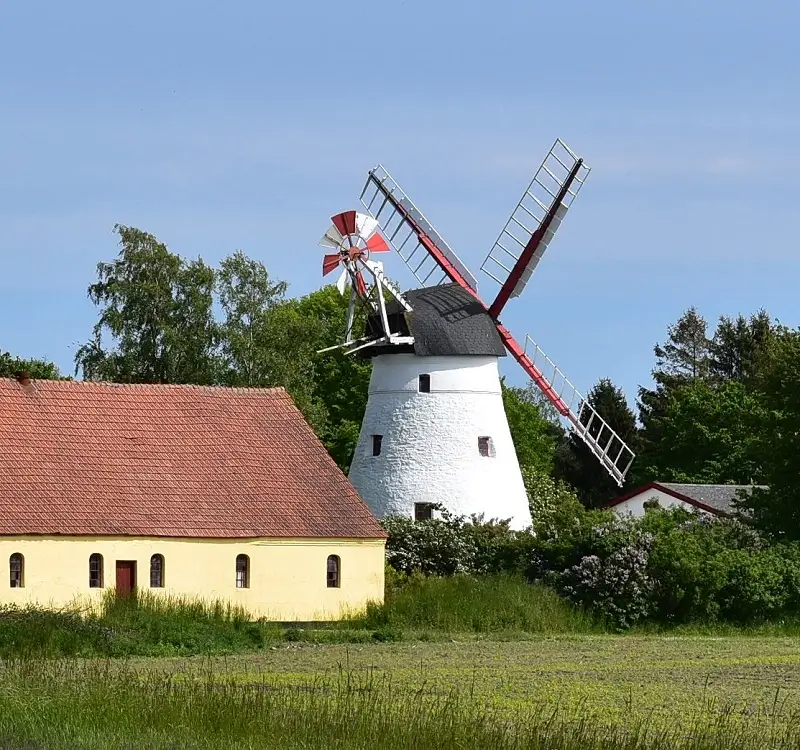
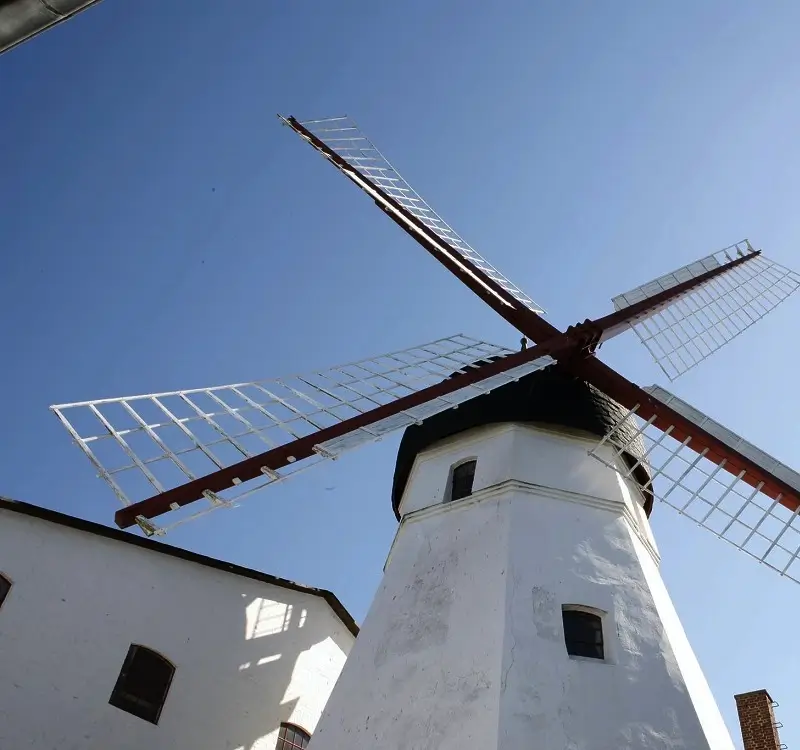
Valsemølle is an octagonal Dutch windmill located on a rocky site south of Aakirkeby. Though it is not easily visible, as it stands within the courtyard of a modern mill still producing flour, Valsemølle has a rich history and is an important part of Bornholm’s heritage. The windmill was built in 1867, replacing an older post mill.
The History of Valsemølle
The windmill ceased operations in 1950, but its story did not end there. In 1976, a fire severely damaged the windmill and surrounding buildings. However, due to its historical significance, a decision was made to restore it. The windmill was renovated, regaining its former glory, and remains a symbol of Bornholm’s industrial heritage.
Kuremølle, located along the road from Svaneke to Østermarie, is one of Bornholm's historic windmills. Almost identical to Svanemølle, it was built by Christian Sommer. In 1900, the mill was taken over by his son, Emil Sommer, who expanded its operations in 1912 by adding a bakery.
The History of Kuremølle
The windmill ceased operations in the early 1950s, but the bakery continued until 1976. After its closure, a group of Kuremølle enthusiasts formed an association to preserve the site. Thanks to their efforts, the windmill was restored and remains in good condition to this day, maintaining its functionality and historical significance.
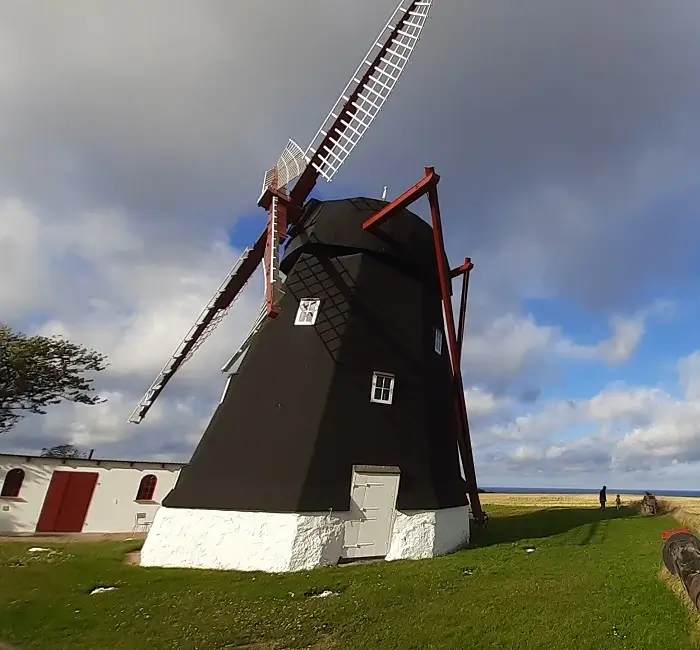
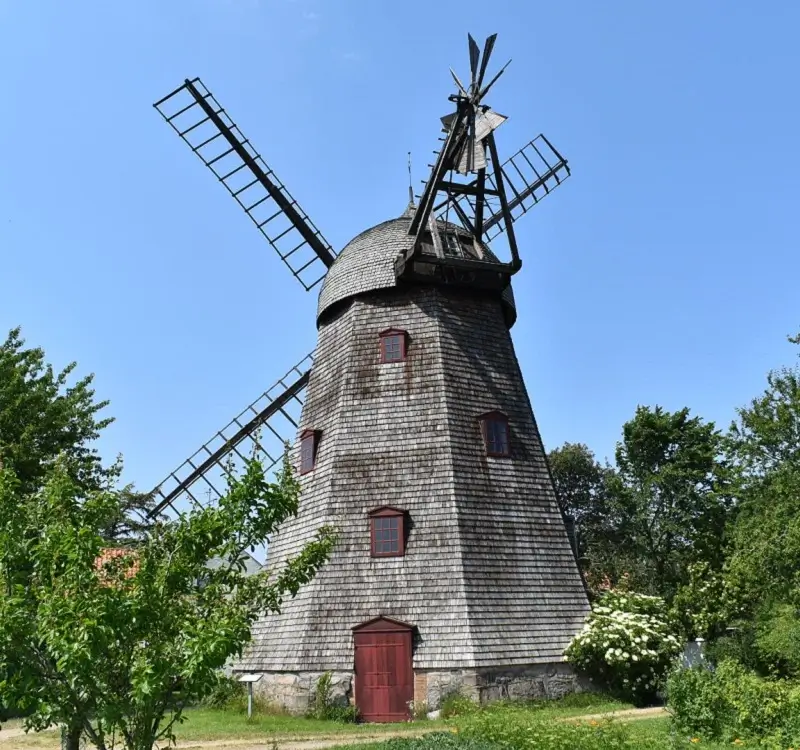
Svanemølle, picturesquely located near Svaneke along the road to Østermarie, is a wooden Dutch windmill with a structure similar to the nearby Kuremølle. Built in 1856, it is one of the best-preserved windmills on Bornholm and a testament to the island’s milling tradition.
The History of Svanemølle
The idea to build Svanemølle emerged in 1855 when 10 residents of Svaneke and Ibsker decided to replace old, dilapidated post mills with a more modern Dutch windmill. The construction was entrusted to Christian Sommer, who completed the mill in 1856. In 1861, the mill was sold to Hans Kofoed, who expanded the site, and in 1895, his son added a bakery. The mill and bakery operated until the 1950s.
After its closure, the mill faced the threat of demolition, but in 1958, it was acquired by the Svaneke community, who restored it in 1960. Thanks to their efforts, Svanemølle has stood the test of time and remains in excellent condition following thorough conservation work.
Saxebro Mølle, located north of Boderne along the road from Rønne to Snogebæk, is a picturesque Dutch windmill with an octagonal structure, built from local sandstone. Together with its adjoining courtyard and former bakery, it forms a unique complex that stands as a testament to traditional milling on Bornholm.
The History of Saxebro Mølle
The windmill and bakery were built simultaneously and served an essential role in the local community for many years. The windmill operated until 1958, when a storm severely damaged its sails, leading to its closure. The bakery continued to function for several more years until it closed in 1986. Currently, there are plans to renovate the windmill with support from sponsors, potentially restoring it to its former glory.
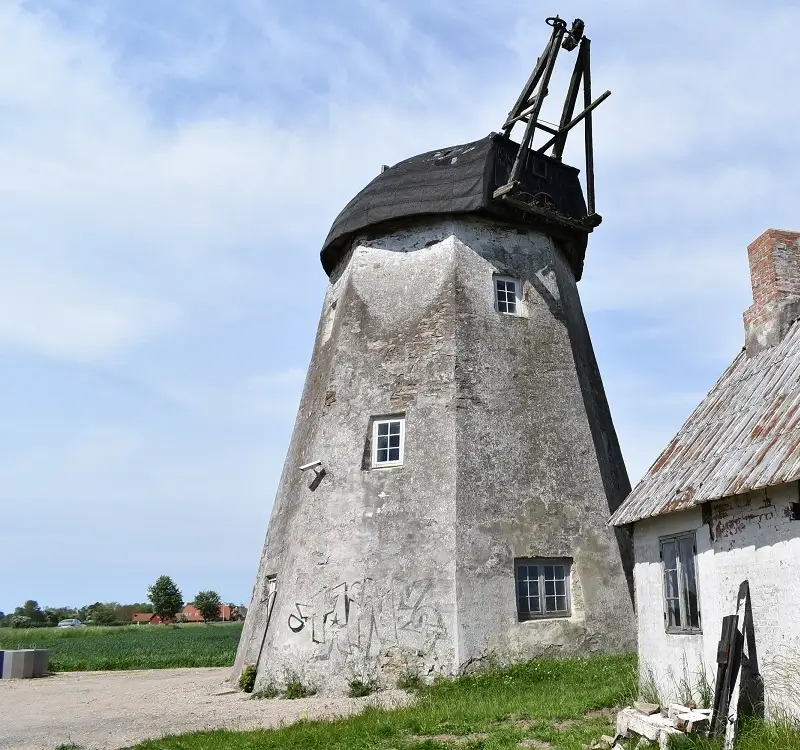
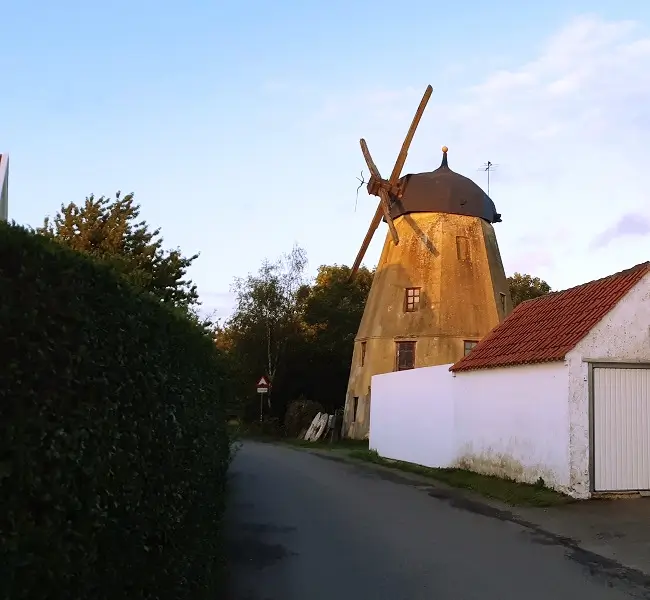
Bakkemølle, located in Nexø, is an octagonal stone mill built in 1871 that played a significant role in local milling for nearly a century. Although the mill ceased operations in 1970, its distinctive structure and history make it an important part of Bornholm's heritage.
The History of Bakkemølle
After the mill's closure in 1970, it was sold in 1984 and repurposed by its new owners. Unfortunately, during this transformation, all the mill's original machinery was removed, leaving only the stone structure. Additionally, the mill's walls were painted yellow, a change that does not reflect its historical appearance or character.
Stenby Mølle, built in 1857 near Rø, is the oldest preserved wooden Dutch windmill on Bornholm. Its unique design and rich history make it an important part of the island’s heritage, though the mill is currently in a state that requires further restoration.
The History of Stenby Mølle
The mill underwent several significant upgrades, including in 1898 when the new owner replaced various structural components. In 1914, a bakery was added, which operated until 1930. Unfortunately, in the late 1950s, all the mill's machinery was removed, leaving it non-functional.
Several attempts have been made to restore the mill, but progress halted after the removal of the cap, which was replaced by a temporary roof to protect the interior from rain. Since then, the mill has been awaiting the installation of a new cap and sails to regain its original appearance.
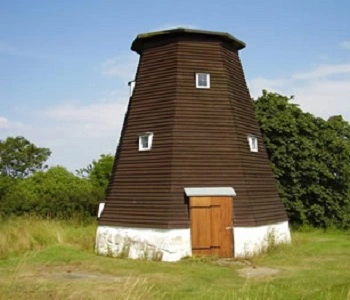
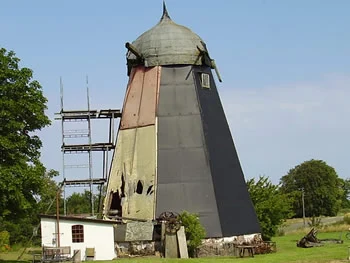
Røbro Mølle, located near Rø, is the youngest preserved wooden Dutch windmill on Bornholm, built in 1895. Its unique design and preserved early 20th-century technology make it an important part of the island's heritage.
The History of Røbro Mølle
The mill underwent modernization in 1906 and 1915 when a new owner upgraded its equipment. The technology from this period has been preserved, serving as a unique example of historic milling on Bornholm. The mill's sails were renovated in 1949, but in 1970 they were removed, affecting its current appearance.
Centuries ago, watermills were a common feature of Bornholm’s landscape, especially along the island’s waterways, where almost every homestead had its own small mill. Initially, horizontal mills, known as splash mills, with horizontally mounted wheels were predominant, but over time, these were replaced by larger mills with vertical waterwheels and horizontal axles.
Watermills were typically timber-framed buildings, consisting of 3–4 compartments and thatched roofs. Bornholm once had many such mills, but today only three remain:
Vang Vandmølle on the western coast,
Slusegårds Vandmølle,
Ågårds Vandmølle.
Although most mills have disappeared, their remnants can still be found along the island’s streams, serving as a reminder of their former glory.
The watermills on Bornholm are not just relics of the past but also remarkable testaments to old technologies and ways of life on the island. Their picturesque locations and unique architecture make them a compelling destination for history buffs, nature lovers, and those interested in traditional craftsmanship.
The Vang Watermill, dating back to 1811, is the best-preserved watermill on Bornholm, having played a vital role in the local community for centuries. After ceasing operations in 1905, the mill was restored in 1927 and designated as a protected historical monument. Today, it stands as a unique testament to the island’s historical watermill technology.
The History of Vang Watermill
After it ceased operation, the mill and its associated residential buildings were sold in 1931. In 1969, the Vang Watermill was acquired by the Bornholm Museum, ensuring its preservation and allowing for further restoration. By 1978, it was the only operational watermill on Bornholm, highlighting its exceptional significance.
Extensive renovation efforts were carried out in 1986 and again between 2010 and 2011, preserving both the interior and exterior structure in excellent condition. The mill, with its distinctive thatched roof and location built into a steep hillside, is a rare example of this type of architecture.
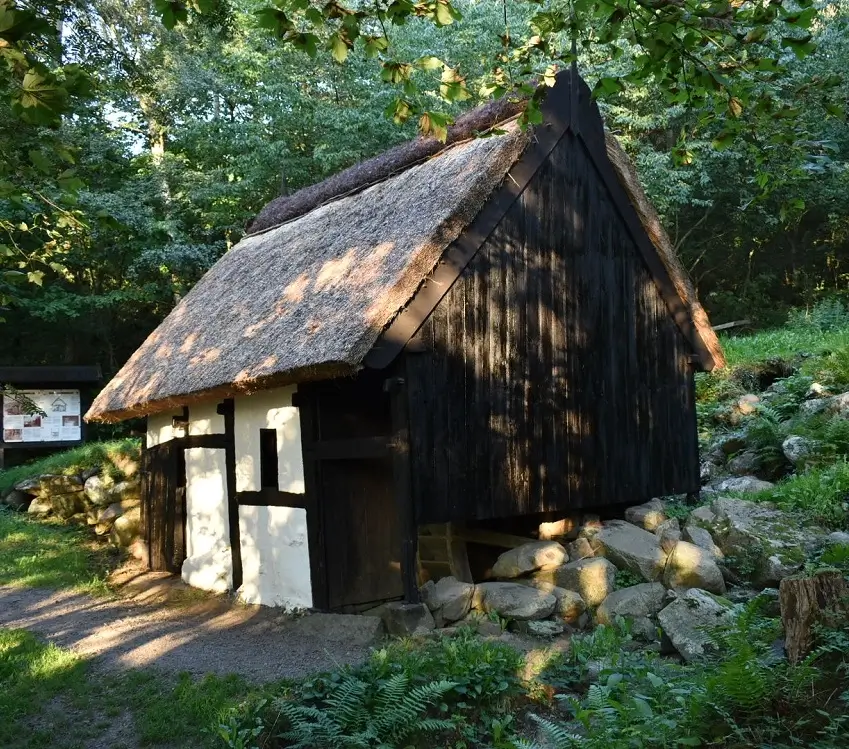
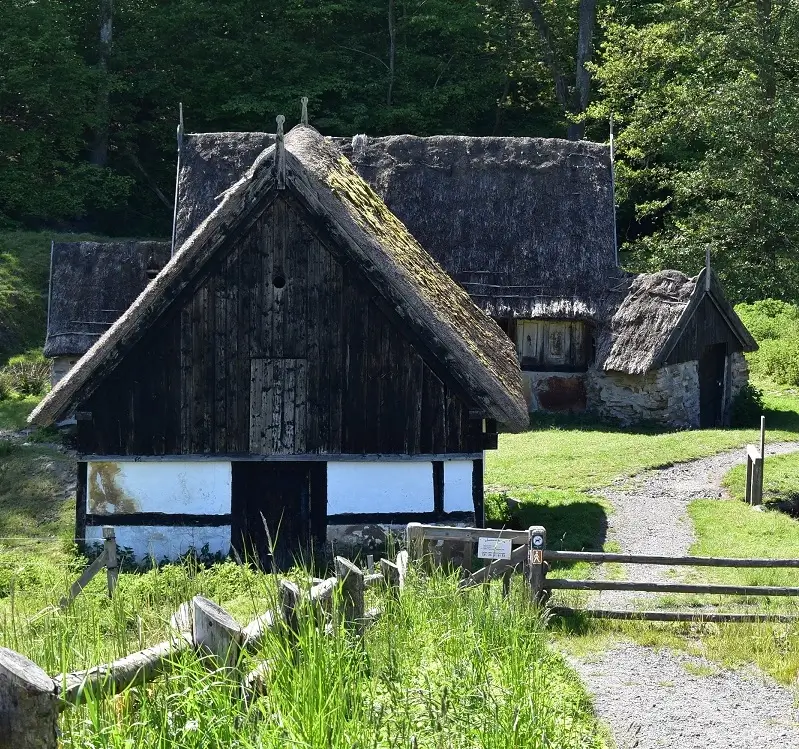
The Slusegård Watermill, located near Sømarken beach and harbor in southern Bornholm, is a unique historical landmark with a rich history. Situated along the Øle Å river, the mill features an attached trout pond fed by fresh water from a nearby spring and various sluice systems. Its picturesque location near a hotel and beach makes it an attractive tourist destination.
The History of Slusegård Watermill
The watermill dates back to the early 18th century, while the Slusegård farm was built later. Initially, the mill was used for grinding grain but also for sawing wood, showcasing its versatility. The mill building, constructed in timber framing and topped with a thatched roof, is an excellent example of traditional Bornholm architecture.
In 1949, the mill changed ownership, and during the 1950s and 1960s, it underwent extensive renovations in collaboration with the Bornholm Museum. In 1989, a new millstone was installed, making the mill fully functional to this day. Both the mill and the trout pond are protected as historical monuments, and the surrounding landscape is designated as a nature reserve.
The Ågårds Watermill, located northeast of Pedersker along the small Øle Å stream, is a small yet charming example of traditional milling on Bornholm. Built using parts of an older structure from the early 18th century, the mill beautifully reflects the character of the small watermills that once dotted the island.
The History of Ågårds Watermill
The mill ceased operation in 1958, but it has been regularly maintained to preserve its original structure. The adjacent mill pond is also carefully managed, adding to the picturesque setting of this historic site. Though modest in size, Ågårds Watermill is a valuable part of Bornholm's heritage, serving as a reminder of a time when watermills were an integral part of local life and industry.
